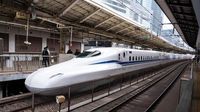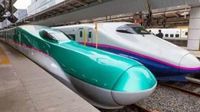In a significant advancement for India’s first high-speed rail project, Japan is set to provide two Shinkansen train sets at no cost to assist with testing and inspection activities along the Mumbai-Ahmedabad corridor. This collaboration, reported by The Japan Times, aims to enhance the development and performance assessment of the under-construction high-speed line, which is a flagship infrastructure initiative for India.
The two train sets, one from the E5 series and another from the E3 series, are expected to arrive in India in early 2026. These trains will be equipped with specialized inspection and data collection instruments, crucial for evaluating operational conditions in India, particularly in relation to challenges posed by high temperatures and dusty environments.
The data gathered during these tests will be instrumental in assessing driving conditions and preparing for the possible local production of the next-generation E10 series trains in India, which are scheduled for introduction in the early 2030s. Until then, India plans to deploy locally manufactured semi-high-speed trains, modified for use on the corridor.
Japan is funding nearly 80% of the bullet train project through low-interest yen loans, a financial commitment that underscores the importance of this initiative for both nations. As costs rise, both governments are expected to negotiate a new loan framework to facilitate the deployment of the E10 series trains. This development is likely to be finalized during Prime Minister Narendra Modi’s forthcoming visit to Japan for a bilateral summit.
The Shinkansen technology, a symbol of Japanese innovation, holds strategic importance for Japan. The deployment of its high-speed models in India represents not only a technological collaboration but also a diplomatic gesture. The E5 model is renowned for its aerodynamic design and advanced technology, while the E3 series is celebrated for its energy efficiency and passenger comfort. Their integration into India’s rail network will provide essential insights into track performance and system operations under Indian conditions.
The National High-Speed Rail Corporation Limited (NHSRCL) is overseeing the construction of the Mumbai-Ahmedabad High-Speed Rail Corridor, which began in November 2021. Since the commencement of work, significant progress has been made, including the construction of six river bridges. These bridges span two over the Par and Auranga in Valsad district, and four others over the Purna, Mindhola, Ambika, and Venganiya in Navsari. In total, the corridor will feature 24 river bridges, with 20 located in Gujarat and the remaining in Maharashtra.
Railway Minister Ashwini Vaishnaw has emphasized the economic integration potential of the corridor. He explained that the project aims to unify the economies of key urban centers such as Mumbai, Thane, Vapi, Vadodara, Surat, Anand, and Ahmedabad. "It would be possible to have breakfast in Surat, travel to Mumbai for business, and return home with one’s family by evening," he noted, highlighting the convenience and connectivity that the project is set to bring.
India's ambitious high-speed rail project is gaining momentum, with Japan preparing to send these iconic Shinkansen trains for trial runs. Capable of reaching speeds up to 320 km/h, these trains will be used to collect crucial data on driving conditions once the civil infrastructure work is completed.
The agreement for this collaboration dates back to 2016, when Prime Minister Narendra Modi signed a deal with his then-Japanese counterpart Shinzo Abe for the manufacturing of Shinkansen trains in India, as part of the Centre's ambitious "Make in India" initiative. This agreement not only facilitates the transfer of Japanese technology to India but also aims to bolster domestic production.
For the approximately 500-kilometer high-speed corridor connecting Mumbai and Ahmedabad, both governments plan to introduce the cutting-edge E10 series Shinkansen trains from Japan Railway in the early 2030s. Low-interest yen loans from the Japanese government are expected to cover about 80% of the project's overall costs, originally estimated at around 1.8 trillion rupees. However, with costs projected to rise, both governments are working diligently to establish a new yen loan framework to ensure the successful introduction of the E10 trains.
The Mumbai-Ahmedabad High-Speed Rail Corridor, once operational, will not only mark India's entry into the realm of high-speed rail travel but also serve as a model for future railway projects across the country. The integration of advanced technology and infrastructure is expected to significantly enhance the efficiency and speed of rail travel in India, transforming the way people commute between major urban centers.
As the project progresses, anticipation grows regarding the potential impacts on economic growth, job creation, and overall connectivity. The collaboration between India and Japan in this venture showcases the importance of international partnerships in achieving ambitious infrastructure goals.
In summary, the arrival of the Shinkansen trains for testing and inspection represents a pivotal moment in India's high-speed rail journey. With the promise of cutting-edge technology and significant financial backing from Japan, the Mumbai-Ahmedabad corridor is set to redefine rail travel in India, paving the way for a future where high-speed trains become a common sight on Indian tracks.





